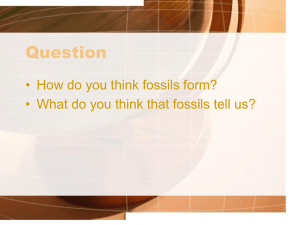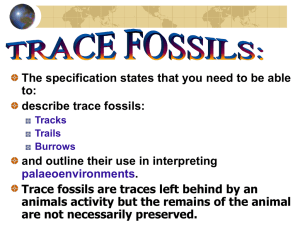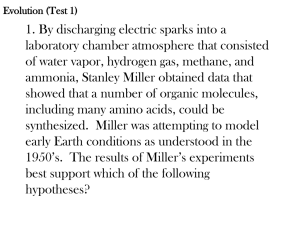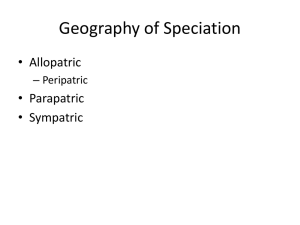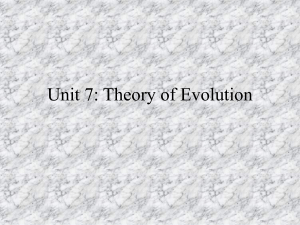allopatric speciation
advertisement
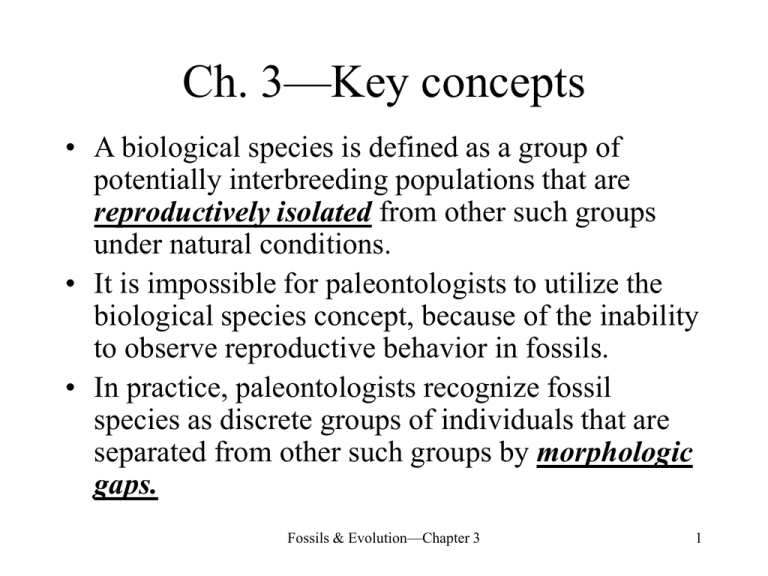
Ch. 3—Key concepts • A biological species is defined as a group of potentially interbreeding populations that are reproductively isolated from other such groups under natural conditions. • It is impossible for paleontologists to utilize the biological species concept, because of the inability to observe reproductive behavior in fossils. • In practice, paleontologists recognize fossil species as discrete groups of individuals that are separated from other such groups by morphologic gaps. Fossils & Evolution—Chapter 3 1 Ch. 3—Key terms • Species – Biological species concept – Morphological species concept • • • • • Sympatric / Allopatric populations Allopatric speciation Cline / chronocline / chronospecies Anagenesis (phyletic gradualism) Punctuated equilibrium Fossils & Evolution—Chapter 3 2 Biological species concept • A species is a group of potentially interbreeding populations that are reproductively isolated from other such groups – Most species are separated geographically into local breeding populations – Populations are reproductively isolated only if interbreeding would not occur if they lived in the same area Fossils & Evolution—Chapter 3 3 Biological species a-d all discrete • Most biologic species are distinct because they belong to evolving lineages that have been reproductively isolated for a long time • Biologists encounter difficulty only when a lineage is branching at the present time! Fossils & Evolution—Chapter 3 morphology 4 Biologic methods of species discrimination • How do biologists establish that two populations represent two species? – Reproductive isolation is difficult to document • Experience shows that distinct populations cannot live sympatrically unless they belong to different species • Therefore, if two distinct populations overlap in their geographic range, they probably represent two species – Mainly, biologists rely on morphologic differences (occasionally with the benefit of biogeographic info) Fossils & Evolution—Chapter 3 5 Sympatric geographic ranges: partial overlap Allopatric geographic ranges: no overlap Fossils & Evolution—Chapter 3 6 The “paleontologic species problem” • It is not possible to apply the biologic species definition to fossils • In practice, a paleontologist includes in a fossil species those specimens that he/she believes would have formed a biologic species had they lived together at the same time Fossils & Evolution—Chapter 3 Are a and f discrete? morphology 7 Origin of species • Speciation vs. anagenesis – Speciation = the splitting of a lineage resulting in an increase in the number of species – Anagenesis = gradual evolution within a lineage whereby one species changes into another (without an increase in the number of species) Fossils & Evolution—Chapter 3 8 Chronocline (produced by anagenesis) Fossils & Evolution—Chapter 3 9 Speciation vs. anagenesis Time 2 Species B Species B Arbitrary boundary “pseudoextinction” Time 1 speciation event Species A Species A Fossils & Evolution—Chapter 3 10 Natural selection and anagenesis • All populations are variable – Variation in the gene pool is expressed outwardly as variation in the phenotypes of individuals – Sources of variation are • Point mutations • Genetic shuffling from sexual reproduction – As time passes, natural selection operates on phenotypic variation • Certain kinds of individuals will have greater reproductive success; these kinds will become more common in the population after many generations Fossils & Evolution—Chapter 3 11 Natural selection and anagenesis • Natural selection is a sorting of individuals – So that a population becomes progressively better adapted to a constant environment, or – So that a population adapts to changing environmental conditions • In a chronologic series of populations, there is a point at which the accumulated differences between a population and the starting population are so great that the two would be reproductively isolated if they had been living together at the same time—at this point, a new species has been formed by anagenesis Fossils & Evolution—Chapter 3 12 Allopatric speciation • If two or more breeding populations of a given species are geographically isolated from one another, they may undergo anagenesis independently until reproductive isolation occurs – One species becomes two (geographic speciation has occurred) – In nature, speciation occurs rapidly in small peripheral populations that have become isolated from the larger parent population (i.e., allopatric speciation) Fossils & Evolution—Chapter 3 13 Allopatric speciation Time 4: secondary sympatry, but with reproductive isolation Time 3: geographic & reproductive isolation Time 2: migration & geographic variation Time 1: homogeneous population Fossils & Evolution—Chapter 3 14 Clines and ring species • Gene flow between adjacent populations of a species may be restricted by partial geographic barriers • If so, then subtle genetic differences among populations may develop (genetic gradient) – Cline = series of populations whose gene pools differ slightly along a genetic gradient • Populations at the extreme edges of a species’ range may be reproductively isolated even though they are connected by a chain of interbreeding populations Fossils & Evolution—Chapter 3 15 Cline Fossils & Evolution—Chapter 3 16 Ring species Fossils & Evolution—Chapter 3 17 Rates of evolution • Most biologists believe that well-established species evolve slowly, because: – Genotypes are so complex and highly integrated that random changes are unlikely to be advantageous – Changes may not “take” in a large, thoroughly interbreeding population • Because large populations resist change, most evolution probably is concentrated in relatively rapid speciation events in peripherally isolated populations Fossils & Evolution—Chapter 3 18 Punctuated equilibrium • Eldridge and Gould 1972 • Once a species is established, it undergoes no significant, directional change: gene pool reaches a state of equilibrium (stasis) • New species arise suddenly through allopatric speciation, then themselves become static entities Fossils & Evolution—Chapter 3 19 Punctuated equilibrium • “Paleontologic species problem” is alleviated somewhat if anagenesis is rare and most evolutionary change is associated with allopatric speciation events • In reality, both anagenesis and speciation occur S.E. = speciation event Fossils & Evolution—Chapter 3 20 Paleontologic species problem • Conclusion: There is no way to overcome the PSP • In practice, fossil species are recognized by the morphologic gaps between one another • Where there is no clearcut gap, there is uncertainty! Fossils & Evolution—Chapter 3 21 Morphologic clusters 9 8 width 7 6 5 4 3 3 4 5 6 7 8 9 10 11 12 13 14 15 length Fossils & Evolution—Chapter 3 22


